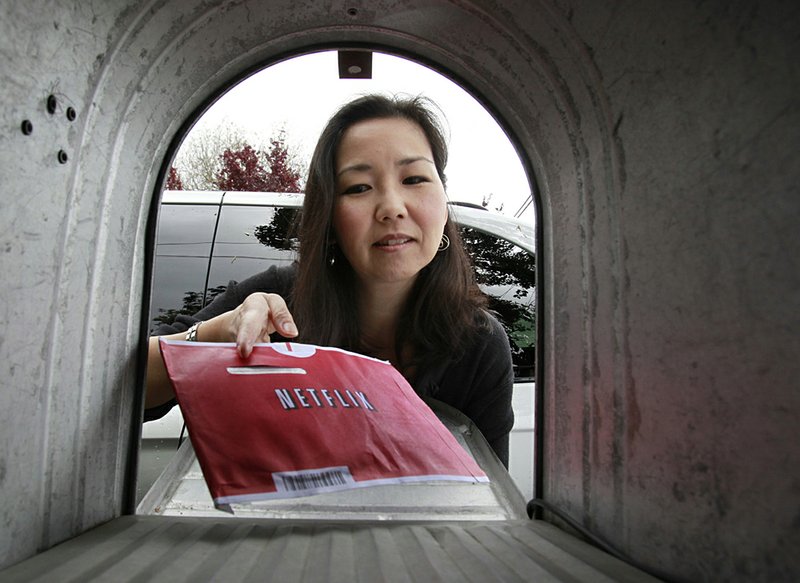SAN FRANCISCO — Netflix is preparing for the day when getting DVDs by mail is as old-fashioned as going to the video store.
It’s hoping to wean people from DVDs with a cheap plan that offers movies and old TV episodes exclusively through online streaming. It will cost $8 per month, matching a recent price cut by rival Hulu.
Most analysts expect the streaming-only plan to appeal to younger subscribers, especially those who have signed up for Netflix in the past couple years as the service became available through video-game consoles. To them, the new price will probably seem like a bargain: Netflix had been charging $9 per month for the lowest-priced plan that included unlimited video streaming.
At the same time, Netflix is making it more expensive to receive those familiar red envelopes in the mail. The company is trying to offset its postage expenses and bring in more money to improve the quality of its Internet streaming library.
The monthly rates on Netflix’s three most popular rental plans will rise $1 to $3, depending on the plan. They will be $10, $15 and $20, depending on how many DVDs the subscriber is allowed to have out at once.
The changes announced last week are Netflix’s latest step to ensure it doesn’t repeat the same mistakes of Blockbuster Inc., a once-ubiquitous video store chain that didn’t adapt quickly enough to technological change and went bankrupt.
Netflix Chief Executive Officer Reed Hastings said he always envisioned movies being piped through high-speed connections - even back in 1999, when his company began mailing out DVD rentals requested on the Web. That expectation is why Hastings says he chose the name Netflix.
But the transition has come more quickly than Hastings had thought. When Netflix added Internet streaming as a free supplement to its DVD plans in early 2007, Hastings assured analysts DVDs would remain the primary way Netflix’s subscribers watched movies for at least the next decade.
That changed as it became possible to stream Netflix’s service through game consoles, Blu-ray players and set-top boxes that are easy to hook up to TVs. Netflix also is streaming on more mobile devices, including the iPad.
Netflix said its 17 million subscribers now watch more hours of Internet-streamed video each month than they do the DVDs they get through the mail.
Even so, Netflix remains a major buyer of DVDs because most of its subscribers still want the discs. That way they can watch the latest movie releases that aren’t available for streaming.
The company doesn’t specify how many DVDs it ships out each month, but Wedbush Securities analyst Michael Pachter estimated the average Netflix subscriber still gets four to five DVDs per month. That’s down from an average of five to six a year ago.
Pachter said he expects DVDs to be around for at least 20 more years. Netflix itself has projected that its DVD-by-mail shipments will peak in 2012 and then progressively decline until they become infinitesimal around 2030.
Meanwhile, subscribers are expected to watch progressively more hours through theInternet. The convenience and perceived value of streaming is the main reason Netflix’s total subscribers have nearly doubled in the past two years.
Netflix Inc. is getting more popular on Wall Street, too. Its stock is worth nine times what it was two years ago and rose to another record high last Monday. The shares gained $15.28, or nearly 9 percent, to close at $188.32. Shares closed out last week at $191.90.
Investors love streaming because it should help Netflix make more money. The simple math: The more people stream, the less the company will have to devote to buying DVDs and getting them to customers. This year, for instance, Netflix is expected to spend more than $700 million on postage and handling.
And streaming will make it easier for Netflix to expand into other countries without having to invest in the dozens of DVD distribution centers it has set up in the U.S. By some estimates, more than 500 million households worldwide are equipped with high-speed Internet connections, and that number is expected to grow in the years to come.
As Netflix’s postage and DVD expenses decline, the company is pouring more money into licensing movies and TV shows for its Internet streaming library.
The streaming catalog is still mostly made up of older movies and TV shows at least a season or two behind. Netflix is trying to freshen that lineup. During the summer, it cut a series of deals that will narrow the time between when movies reach the theater screens and Netflix’s streaming library.
All told, Netflix’s commitments for streaming rights totaled $1.1 billion as of Sept. 30, up from $115 million at the end of last year.
Sales and rentals of DVDs and Blu-ray discs fell 7 percent to $10.9 billion in the first nine months of this year compared with last year, according to The Digital Entertainment Group, an industry body. Meanwhile, Internet downloads rose 37 percent to $432 million.
Netflix’s streaming ambitions could suffer a setback if the cable and telecommunications companies that provide high-speed Internet service attempt to impose surcharges on heavy users of Web video.
Streaming through Netflix accounts for more than 20 percent of peak traffic to Internet users in the U.S., according to a recent report by Sandvine Inc.
Attempts by Internet service providers to charge extra fees to customers who use a lot of data have so far been quashed by consumer backlashes, and Hastings is betting extra fees won’t become a hurdle for Internet video. But that doesn’t mean the cost of high-speed Internet service won’t rise if people get hooked on video streaming.
Business, Pages 21 on 11/29/2010
